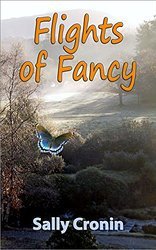Phillip T. Stephens's Blog: Wind Eggs, page 10
June 7, 2017
Fantasy and the problem with Tolkien
I’m going to offer a different slant on Sue Vincent’s blog Fantasy and the Problem with Tolkien (spoiler alert: she doesn’t see one), and I hope you think about both. Whether you’re a reader or writer.
I stumbled across the Lord of the Rings in 1969, stuffed on the back shelf of the libraries science fiction section. I spent a month reading it (I was a sophomore in high school.) At the time, only one other student in my school had read it, a geeky redhead named Peter Polhemus who was really into those Avlon Hill war games with the dice and big grids. At the time fantasy didn’t model Tolkein and I read more eagerly. But at the time, novelists didn’t shoot for trilogies and quadrilogies and septlogies. They wrote books, and if they turned into a series, they didn’t try to put a number on them.
Two things happened. I aspired to other books that captured characters as vividly as Tolkeins. Someone introduced me to Lewis and the Perelandra series, and from there I picked up the Lion, the With and the Wardrobe.
But I also found Vonnegut, Philip Roth, Anthony Burgess, Orwell, Keasey, Huxley and even the pulp of Robert Howard. I realized it isn’t the formula that drives a narrative (unless I wanted to knock out a book overnight because I was stoned and bored, Monty Python wasn’t showing nightly and Texas PBS didn’t broadcast Doctor Who because he was a fop.)
That’s when they started cranking out the trilogies and then octologies. And every one bored me to tears. Why? Because I knew exactly what would happen. The hero would travel to a new land with strange creatures and a new language the author just knew I needed to learn because people in other dimensions don’t talk like us, and have different customs (although they all wore medieval clothes, bore medieval weapons and the world was littered with exotic animals). By the time I was forty I had to explain to my son why I didn’t want to read another fantasy series he recommended because a hero is a stalker instead of a hunter isn’t really different. I could tell him the plot of his series before he told me: New world, hero(ine) who doesn’t know he/she’s the chosen one, magic talisman, new vocabulary, arch villain trying to take control, band of allies, quest, other species the hero must meet (and us too).
When I would sit in writing circles I fell asleep as soon as someone opened their story with “Falderin adjusted his breeches and listened for the hooting of the horned wart owl.” I would struggle to find something kind to say, but I couldn’t. I could only say, “Write something you haven’t read sixty times already.”
So why did Harry Potter work when so many failed? Because Rowling created compelling characters. The formula ranked second.
Tolkein ultimately led me to a love of literature that led me to Thomas Pynchon, Flannery O’Connor, Walker Percy, Saul Bellow, Doris Lessing.
Doris Lessing. She wrote sci fi/fantasy that broke the mold. Her Canopos in Argos series still occupies a place on my shelf even though I couldn’t make it through the first two hundred pages of Lord of the Rings the last time I tried to read it.
You see, I realized I’d outgrown Tolkein after three readings. Like Lewis, the language and characters never conveyed emotion and depth like their contemporaries Lessing, Iris Murdoch and Joh Fowles.
So why do I still celebrate the Lord of the Rings? Because it was a gateway to truly great literature for a (literally) sophomoric 10th-grade mind. But sooner or later we must push the envelope of our reading, just as Frodo pushed the envelope of his courage. When others turned back to their comfort zones, he and Samwise pushed deeper and deeper into the heart of darkness, into unfamiliar territory, into realms that called upon them to use every resource they had.
We should follow their example.
 Painting: Sue Vincent
Painting: Sue Vincent
It has to be said that Tolkien causes problems. Quite apart from being so addictive that, once read, you are likely to go back and read the books again, you may never find anywhere quite as rich as Middle Earth within the pages of another book.
Anyone whose introduction to fantasy is via The Hobbit and Lord of the Rings, will have a fabulously detailed, multi-layered and multicultural world permanently established in their imagination. Especially if you go on to read The Silmarillion too and become aware of the rich complexity and authenticity of the languages, histories and mythologies he created as the backdrop for his world. Tolkien’s elves, orcs and wizards will quickly become the standard by which all others are judged. The sheer scope of the story means that just about every possible trope is used, and every mythical or magical species is covered…
View original post 745 more words


June 5, 2017
EDITING 101: 40 – Editing Myths…
Susan Uttendorfsky and the crew at Adirondack Editing explore a few popular rules about editing.
I prefer “guidelines” because language is a tool. It works if you apply is with mastery and breaks if you don’t use it well. I agree with their assessment of the guidelines. However, never forget guidelines develop for reasons which may or may not continue to apply. Nonetheless, many readers believe those same rules apply. Break their rules too often and they judge your writing rather than read.
If you can follow the guidelines, and it makes sense to do so, I would (and I do). If, however, ignoring them creates a delightful effect, or improves the rhythm and flow of your sentence, then don’t hesitate to ignore them.
 Chris The Story Reading Ape's Blog
Chris The Story Reading Ape's Blog
Originally posted as the Dun Writin’—Now Whut? series on this blog, EDITING 101 is a weekly refresher series for some of you and brand new for others.
Courtesy of Adirondack Editing
Editing Myths
I’m sure you’ve heard of these “rules” that need to be applied to your manuscript. Today we’re going to debunk them as myths!
Never start a sentence with a conjunction (and, but, or), however, or because.
Never end a sentence with a preposition.
Passive voice is always wrong.
You use “a” before words that start with consonants and “an” before words that start with vowels.
Don’t use who when the rules call for whom.
Don’t split an infinitive verb with an adverb.
The only way to write a possessive is to add ’s to the word.
Data and media are plural nouns and always take a plural verb.
Because the English language is fluid and adjustable, there is no…
View original post 410 more words


June 3, 2017
What stories are told over the washing…ART FOR WRITERS
Bridget Whelan shares with readers a Gerald Dillon painting of two women washing at a communal fount. The painting is built from four shapes, a large square framing two ovals with a triangle at bottom center of the frame (fount).
At first glance the picture appears to be perfectly symmetrical, which your first art or design class will discourage. But it’s not. Notice how the unbalanced row of houses breaking the top half of the painting disrupts the symmetry.
Symmetry and balance are important elements in writing. Consider two characters who have equal weight in your prose. Can you structure your piece to achieve symmetry between them? Now, how can you throw that symmetry off-balance, bringing tension to the prose. An overbearing mother? A lover returning to reclaim the character who abandoned him? Or could she reveal secrets her lost love doesn’t want revealed.
Tension in narratives captures readers’ attention, but an unbalanced story disturbs them. How can you play with both to keep your readers’ engrossed?
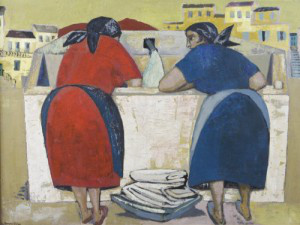
….or confidences exchanged over the washing up… When I was younger I resented the women being ‘banished’ to the kitchen at family gatherings, tied to the drudgery of clearing up after the food had been consumed, leaving the men to relax in the living room and would have none of it. Later I knew the kitchen to be the place where the best stories were told and the laughter was the loudest. Dreary repetitive work on your own grinds down the soul; the company of others lightens the burden, helps to carry the day and season it.
I like this painting of Italian women washing clothes in the big communal stone baths I’ve seen on holiday, most of which are now unused or converted to some other purpose. I like the symmetry of the women’s bodies and the bond it creates. A communal setting like this could form the structure…
View original post 144 more words


June 1, 2017
Smorgasbord Short Stories Lit Fest- June 9th – 12th -Storytellers wanted – Sally at the #Bloggersbash
If you’ve got a short story you’re willing to share, Sally Cronin is looking for submissions for her short story lit fest. She’s got one of the best blogs out there and she loves to promote writers.
 Smorgasbord - Variety is the spice of life
Smorgasbord - Variety is the spice of life
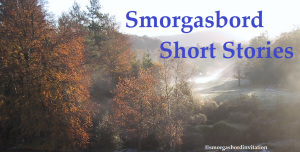 If you have not heard, I am packing my bags, polishing my dancing shoes and working with weights to get my arms hugging fit. I am off on June 9th to London so that I can finally attend one of the best #BloggersBashAwards ever.
If you have not heard, I am packing my bags, polishing my dancing shoes and working with weights to get my arms hugging fit. I am off on June 9th to London so that I can finally attend one of the best #BloggersBashAwards ever.
As you know, I do like to leave a little something for you here when I am off on a jaunt, and this time I am loading the blog with short stories.
I will be sharing stories across the four days from Geoff Cronin from his second book of tales set in Waterford in the 1920s and 1930s.
I will also be sharing my own fiction stories from Flights of Fancy, Tales from the Garden and What’s in a Name Volume One.
It would be lovely to have some of your short stories to post as well and I am looking for fiction appropriate for…
View original post 89 more words


May 30, 2017
What Editing Software Can Teach You about Your Writing
Brenda Berg offers a list of editing boards and apps to help polish your prose. Her best advice? Pay attention to the corrections so you can improve your writing.
Personally, I use Grammarly and the free version of Natural Writer. I then read the final draft out loud while Carol reads a copy, and, using four eyes (eight if you count our glasses), we catch even more typos.
Editing software can’t help you restructure your stories, recognize writing that’s dead on arrival, or suggest a truly beautiful phrase. For that, you need a local or online group (she recommends several) that doesn’t simply say, “Good job.”
 This is a guest post by Brenda Berg, a professional consultant and tutor for college students and entrepreneurs with over 15 years experience in business management, marketing, and entrepreneurship. Brenda is passionate about covering topics on career, self-development, e-learning on her blog Letsgoandlearn.com. She believes that constant learning is the only way to success.
This is a guest post by Brenda Berg, a professional consultant and tutor for college students and entrepreneurs with over 15 years experience in business management, marketing, and entrepreneurship. Brenda is passionate about covering topics on career, self-development, e-learning on her blog Letsgoandlearn.com. She believes that constant learning is the only way to success.
What Editing Software Can Teach You about Your Writing
 As every writer knows, the practice of writing can be a fulfilling, exciting and amazing pastime, whether practiced as a hobby or as a career. On the other hand, it can also be an incredibly frustrating, difficult and even daunting skill that leaves us pulling our hair out.
As every writer knows, the practice of writing can be a fulfilling, exciting and amazing pastime, whether practiced as a hobby or as a career. On the other hand, it can also be an incredibly frustrating, difficult and even daunting skill that leaves us pulling our hair out.
We all have our strengths and weaknesses but when it comes to editing our content, but sometimes, we are left feeling stumped. Luckily, especially in the more recent years where technology has flourished and become more accessible than…
View original post 921 more words


May 29, 2017
Libraries and Bookstores Are Getting Into Indie Publishing – BookWorks
The publishing world changes rapidly. Now libraries are opening indie bookstores.
Source: Libraries and Bookstores Are Getting Into Indie Publishing – BookWorks


May 22, 2017
What Makes a Great Book Cover?
Time and time again I read that books need great covers to sell. Time and time again I don’t even read the description of an indie book because the cover looks so bad. They may have done it themselves or spent fifteen dollars on a low-bid website. For instance:
Butt-ugly typeface downloaded from a free site because it looked “cool.”
A foreground object floating dead center.
Perfectly symmetrical centered type all the way down the cover.
No discernable color palette.
My granddaughter really could do a better job and she draws like an eighth grader. Which she is.
[image error]
Which of the three books is most likely to engage a buyer? (Not just a reader but someone willing to spend their money.)
Belinda Lanks opens the minds of master book designers to see how they think. Please note that none of the covers resemble the indie books on Amazon and Smashwords.


Bookism: The Silent Threat to Good Writing
“Said is dead.” Mrs. Brassballs crossed the room and tossed Johnny’s manuscript in front of him. “Thirty-nine lines of dialogue. Thirteen uses of the word “said.” Any thoughts?”
“I like “said” better than, ‘he bellyached, she postulated, and he argued,'” he said.
Although Mrs. Brassballs may be right about using said 39 times with 39 lines of dialogue, “said” has its uses.
I prefer to identify characters by blocking their action into the paragraph. But there’s nothing wrong with a healthy mix, and sometimes “said” keeps the flow better than anything else.
Diane Tibert shares her thoughts on “said.”
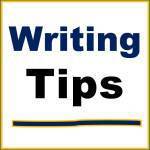 When creating fiction, writers will inevitable have to learn how to write dialogue. I have never read a novel without it though I suppose one exists somewhere out there. One vital key to good dialogue is attributing the spoken words to the proper character, so readers instantly know who is saying them.
When creating fiction, writers will inevitable have to learn how to write dialogue. I have never read a novel without it though I suppose one exists somewhere out there. One vital key to good dialogue is attributing the spoken words to the proper character, so readers instantly know who is saying them.
We do this by using dialogue tags: “The last time I heard this song by Charlie Rich,” Liam said, “you were young, adventurous and in love with me.”
The words Liam said is a direct dialogue tag. It tells the reader without fuss or doubt that Liam said those words inside those quotation marks.
Another method of informing readers of who said what is through an action by the character. This is technically not called a dialogue tag, but it does the same job.
For example: “This was my favourite show when I was a kid.” Judy grabbed…
View original post 933 more words


To publish or find a publisher?
There’s still a month left in spring. This is the time when young writers hastily type the last paragraph of their novel, add “The End,’ glance out the window at the young people in the park and their thoughts turn to publication. They embrace their novel like a child: It’s brilliant, beautiful and better than any other novelist’s first work. Of course, you have to show it off.
So they dress their novels up show it to some friends and (hopefully objective) readers.1 Their friends pat them on the back, and, if you’re like many young writers, you write off the concerns of objective readers. You know the world needs to see your child.
[image error]
This chart was intended to help writers decide between traditional and self publishing, but it doesn’t tell the complete picture.
Now for the big question: Do you seek the perceived legitimacy of a publisher or do you shortcut the process and publish your book on Amazon and other indie book sites?
A fellow blogger published the chart I included (if anyone knows the source I’ll be glad to credit them) showing the question as a set diagram. It’s one of the more useful charts I’ve seen, but it’s flawed in a few areas. Before you make the decision to go with a publisher or do it yourself, let me share a few topics I don’t often see discussed:
Promotion
No matter which route you choose, plan to promote yourself. I attended several writers’ conferences talked personally to agents and editors and sat through countless seminars on branding and platform (well before those buzzwords existed). They all delivered the same message: even if you sell your book to a publisher, you’ll end up in charge of marketing.
The only time book publishers seriously invest in marketing (end caps, advertising and advance word of mouth) is when they expect to sell thousands of copies in hardcover, trade paper and ePrint. Sadly, most publishers don’t recognize the J.K. Rowling until she’s sold her first thirty thousand copies. They’re too busy looking for the last J.K. Rowling.)
The best you can hope for is a small advance check, a contract for your next book and the promise that you don’t have to pay the advance back when your book hits the remaindering shelf.
The worst you can hope for is to never receive your royalties, never see a sales report and discover you sold your rights to the publisher because you didn’t hire a lawyer or agent to review the contract.
The realities of book production.
I worked with digital prepress and then eBook development since PageMaker 1. Photoshop was a NASA shareware program that I used for filters. I remember when people believed FreeHand would put Illustrator out of business and Quark XPress would kill PageMaker.2 I edited several journals and online publications and produced books for publishers such as The Texas Monthly Press. The decision to self-publish was a no-brainer. Traditional publishing wouldn’t improve my terrible marketing skills, so I might as well learn them for a book I published.
New writers should consider this step carefully. Too many indie books are poorly written. That’s not the problem. A good editor can turn a horribly written book with a great premise into a readable novel.
Too many indie novels are also horribly edited and released with terrible covers using typefaces that should never have been created. If I reviewed covers with my reviews of indie novels, they’d drop a notch or too in my recommendation.
You need to work with a real writing group (not an “attaboy, you did great” group), or take a college writing class (I recommend both). You need to pay for beta readers, an editor and maybe, when push comes to shove, a traditional publisher. Even if they don’t provide an advance, they do step up with professional editing and design.
Provided, as I mentioned earlier, you read the contract or, better yet, contracted with an agent. Many new writers think agents only sell their books to publishers and then buy them drinks and become personal assistants (I saw those movies too). Agents actually protect you from your publisher who will be trying to eke every penny they can from your contract.
Of course, you want to be as selective with your agent as with a publisher.
So think carefully and do your research. Prepare to spend time and money, even when publishing yourself.
Find beta readers and writing groups that cut your prose to shreds. Then hire an editor (check for samples of their work too, and then listen to them, which many writers refuse to do). Only then will you be ready to make a real decision about publishing.
Notice that I said friends, not family. Many families will respond like friends, but if your family is like my family (and you’ll know from long history if they are) they’ll tell you why should give up this stupid idea and beg your boss to keep you in the job you hate because you’re a writer. ↩︎
It did, but only because Adobe re-released PageMaker as a massive upgrade called InDesign, which sealed Quark’s fate. ↩︎
Book Reviews
check out my books at Amazon.com


May 18, 2017
How To Radically Revise Your Novel
Rachel Poli offers writers tips for radically rewriting novels you can’t nail down. These suggestions might seem to ask a lot of you, but two of my published novels contain maybe 50 of the pages in their first drafts. You might want to consider these strategies.
Radical revision is a term to revise or rewrite your current draft. It’s a tool to help your reimagine your story.
This is a method I learned in school when I was working on my English degree. I’ve kept the notes these past two years because I found it to be helpful and a pretty cool method. It didn’t seem so at the time because it was homework, but I do think it helps.
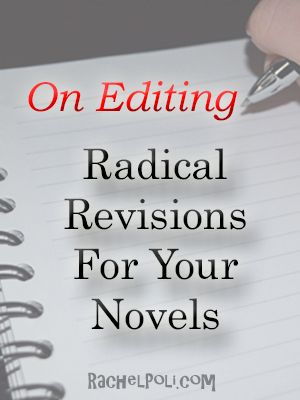 What does radical revision do?
What does radical revision do?
The point of radically revising your novel is to try something new, something different you wouldn’t normally do. Rewrite your current draft in a new way and see which one works better.
It may or may not work, but you’re experimenting, getting to know your novel and characters at a deeper level, and you’re practicing new forms of writing.
In a way, I guess you could look at this as a…
View original post 503 more words


Wind Eggs
As much as I admire Plato I think the wind eggs exploded in his face and that art and literature have more to tell us, because of their emotional content, than the dry desert winds of philosophy alone. ...more
- Phillip T. Stephens's profile
- 31 followers





